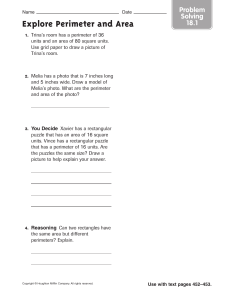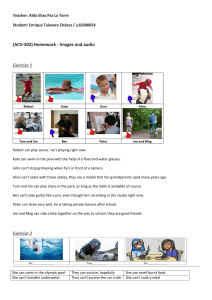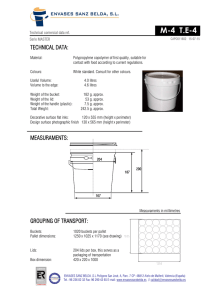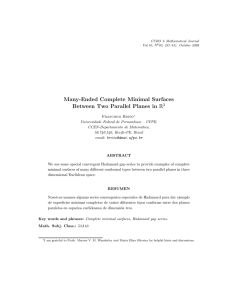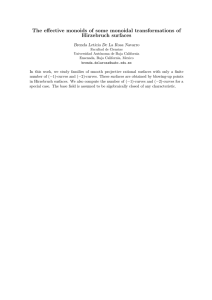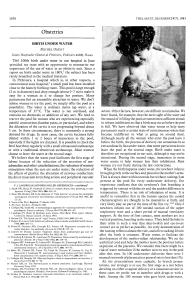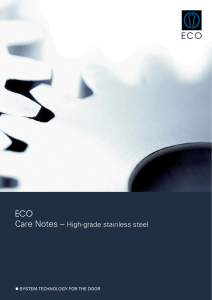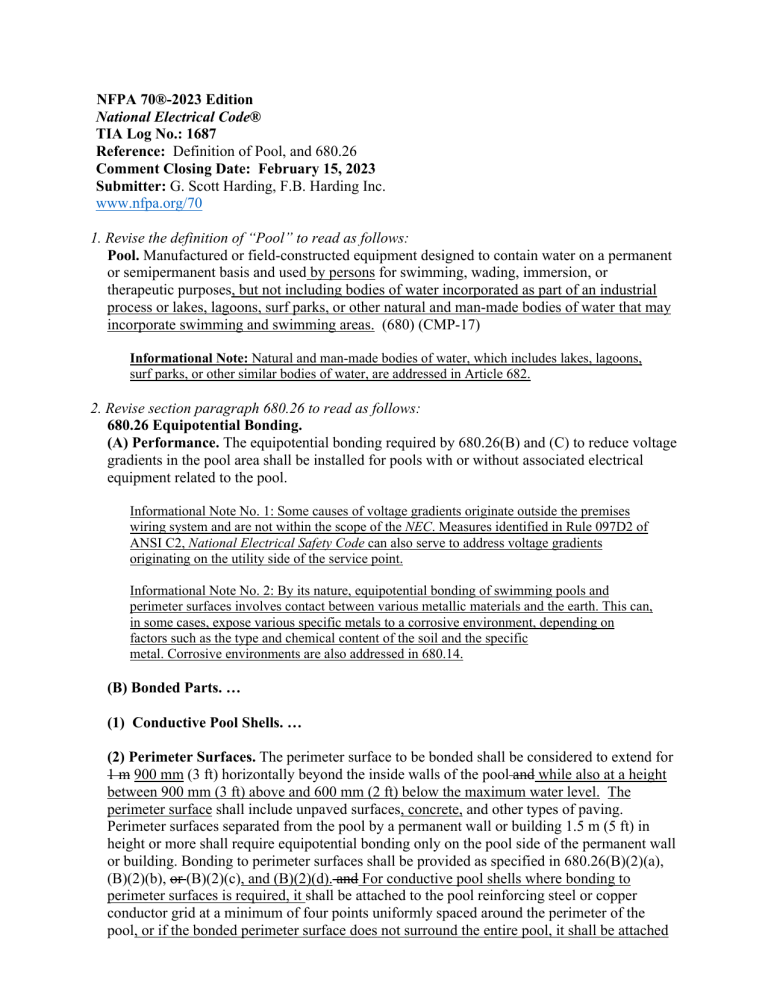
NFPA 70®-2023 Edition National Electrical Code® TIA Log No.: 1687 Reference: Definition of Pool, and 680.26 Comment Closing Date: February 15, 2023 Submitter: G. Scott Harding, F.B. Harding Inc. www.nfpa.org/70 1. Revise the definition of “Pool” to read as follows: Pool. Manufactured or field-constructed equipment designed to contain water on a permanent or semipermanent basis and used by persons for swimming, wading, immersion, or therapeutic purposes, but not including bodies of water incorporated as part of an industrial process or lakes, lagoons, surf parks, or other natural and man-made bodies of water that may incorporate swimming and swimming areas. (680) (CMP-17) Informational Note: Natural and man‐made bodies of water, which includes lakes, lagoons, surf parks, or other similar bodies of water, are addressed in Article 682. 2. Revise section paragraph 680.26 to read as follows: 680.26 Equipotential Bonding. (A) Performance. The equipotential bonding required by 680.26(B) and (C) to reduce voltage gradients in the pool area shall be installed for pools with or without associated electrical equipment related to the pool. Informational Note No. 1: Some causes of voltage gradients originate outside the premises wiring system and are not within the scope of the NEC. Measures identified in Rule 097D2 of ANSI C2, National Electrical Safety Code can also serve to address voltage gradients originating on the utility side of the service point. Informational Note No. 2: By its nature, equipotential bonding of swimming pools and perimeter surfaces involves contact between various metallic materials and the earth. This can, in some cases, expose various specific metals to a corrosive environment, depending on factors such as the type and chemical content of the soil and the specific metal. Corrosive environments are also addressed in 680.14. (B) Bonded Parts. … (1) Conductive Pool Shells. … (2) Perimeter Surfaces. The perimeter surface to be bonded shall be considered to extend for 1 m 900 mm (3 ft) horizontally beyond the inside walls of the pool and while also at a height between 900 mm (3 ft) above and 600 mm (2 ft) below the maximum water level. The perimeter surface shall include unpaved surfaces, concrete, and other types of paving. Perimeter surfaces separated from the pool by a permanent wall or building 1.5 m (5 ft) in height or more shall require equipotential bonding only on the pool side of the permanent wall or building. Bonding to perimeter surfaces shall be provided as specified in 680.26(B)(2)(a), (B)(2)(b), or (B)(2)(c), and (B)(2)(d). and For conductive pool shells where bonding to perimeter surfaces is required, it shall be attached to the pool reinforcing steel or copper conductor grid at a minimum of four points uniformly spaced around the perimeter of the pool, or if the bonded perimeter surface does not surround the entire pool, it shall be attached to the pool reinforcing steel or copper conductor grid at a minimum of four uniformly spaced points along the bonded perimeter surface. For nonconductive pool shells where bonding to the perimeter surfaces is required, bonding at four points shall not be required, and the perimeter bonding shall be attached to the 8 AWG copper equipotential bonding conductor and, if present, to any conductive support structure for the pool. Informational Note: Because the perimeter surface can incorporate various types of materials at various locations and elevations above and below maximum water level, the perimeter surface required to be bonded might not surround the entire pool. The 8 AWG copper equipotential bonding conductor can encircle the entire pool to facilitate connection of bonded parts. (a) Structural Reinforcing Steel. Structural reinforcing steel shall be bonded in accordance with 680.26(B)(1)(a). Conductive Paved Portions of Perimeter Surfaces. Conductive paved portions of perimeter surfaces, including masonry pavers, if used, shall be bonded with unencapsulated structural reinforcing steel in accordance with 680.26(B)(1)(a), or with unencapsulated steel structural welded wire reinforcement (welded wire mesh, welded wire fabric), bonded together by steel tie wires or the equivalent. Steel welded wire reinforcement shall be fully embedded within the pavement unless the pavement will not allow for embedding. If the reinforcing steel is absent, or is encapsulated in a nonconductive compound, or embedding is not possible, unencapsulated welded wire steel reinforcement or a copper conductor grid shall be provided and shall be secured directly under the paving, and not more than 150 mm (6 in.) below finished grade. Unencapsulated steel welded wire reinforcement that is not fully embedded in concrete, and copper grid regardless of location, where used for equipotential bonding, shall be listed for corrosion resistance and mechanical performance. This listing requirement shall become effective January 1, 2025. The copper grid or unencapsulated steel welded wire reinforcement shall also meet the following: (1) Copper grid is constructed of 8 AWG solid bare copper and arranged in accordance with 680.26(B)(1)(b)(3). (2) Steel welded wire reinforcement is minimum ASTM 6x6‐W2.0 x W2.0 or minimum No. 3 rebar constructed in a 300 mm (12 in.) grid. (3) Copper grid and steel welded wire reinforcement follow the contour of the perimeter surface extending not less than 900 mm (3 ft) horizontally beyond the inside walls of the pool. (4) Only listed splicing devices or exothermic welding are used. Informational Note No. 1: Performance of the equipotential bonding system at the perimeter surface is improved as the distance between the bonding means and finished grade is minimized, either by embedding within, or by direct contact with the underside of, the finished pavement. Informational Note No. 2: See ASTM A615/A615M, Standard Specification for Deformed and Plain Carbon‐Steel Bars for Concrete Reinforcement; A1064/A1064M Standard Specification for Carbon‐Steel Wire and Welded Wire Reinforcement, Plain and Deformed, for Concrete; A1022/A1022M Standard Specification for Deformed and Plain Stainless Steel Wire and Welded Wire for Concrete Reinforcement; A1060A/A1060M, Standard Specification for Zinc‐Coated (Galvanized) Steel Welded Wire Reinforcement, Plain and Deformed, for Concrete; and ACI Standard ACI 318, Building Code Requirements for Structural Concrete, for examples of standards currently used in the listing of reinforcing steel bars and steel welded wire reinforcement. (b) Unpaved Portions of Perimeter Surfaces. Unpaved portions of perimeter surfaces shall be bonded with any of the following methods: (1) Copper Ring. Where structural reinforcing steel is not available or is encapsulated in a nonconductive compound, a cCopper conductor(s) shall be utilized where the following requirements are met meet the following: (1)a. At least one minimum 8 AWG bare solid copper conductor, including the 8 AWG copper equipotential bonding conductor if available shall be provided. (2)b. The conductors shall follow the contour of the perimeter surface. (3)c. Only listed splicing devices or exothermic welding are used. shall be permitted. (4)d. The required conductor(s) is shall be 450 mm to 600 mm (18 in. to 24 in.) from the inside walls of the pool. (5)e. The required conductor(s) shall be secured within or is under the unpaved portion of the perimeter surface 100 mm to 150 mm (4 in. to 6 in.) below the subgradefinished grade. f. Be installed only in perimeter surfaces not intended to have direct access to swimmers in the pool. (c2) Copper Grid. Where structural reinforcing steel is not available or is encapsulated in a nonconductive compound, cCopper grid or unencapsulated steel welded wire reinforcement used for equipotential bonding of unpaved portions of perimeter surfaces shall be utilized where the following requirements are met meet the following: (1)a. The copper grid shall be constructed of 8 AG solid bare copper and be arranged Be installed in accordance with 680.26(B)(1)(b)(3)(B)(2)(a). (2) The copper grid shall follow the contour of the perimeter surface extending 1 m (3 ft) horizontally beyond the inside walls of the pool. (3) Only listed splicing devices or exothermic welding shall be permitted. (4)b. The copper grid shall be secured Be located within or under the deck or unpaved surface(s) between 100 mm to 150 mm (4 in. to 6 in.) below the subgradefinished grade. (c) Nonconductive Perimeter Surfaces. Equipotential bonding shall not be required for nonconductive portions of perimeter surfaces that are separated from earth or raised on nonconducting supports, and it shall not be required for any perimeter surface that is electrically separated from the pool structure and raised on nonconductive supports above an equipotentially bonded surface. Informational Note: Nonconductive materials include, but are not limited to, wood, plastic, wood‐plastic composites, fiberglass, and fiberglass composites. (d) Interconnection of Bonded Portions of Perimeter Surfaces. All surfaces where equipotential bonding is required shall be interconnected using listed splicing devices or exothermic welding. Where copper wire is used for this purpose, it shall be solid copper, not smaller than 8 AWG. The conductor shall be permitted to encircle the pool to facilitate bonding connections to portions of the perimeter covered in 680.26(B)(2)(a) and (B)(2)(b) that are not contiguous. Substantiation: This Tentative Interim Amendment (TIA) is proposed by a Task Group appointed by NFPA staff pursuant to the decision of the Standards Council D#22-3 on Agenda item SC#22-8-5-w-1 as voted 12 August 2022. This decision denied the underlying appeal, but found that issues raised at the hearing relative to current research and loss experience required “timely analysis.” Given the “highly technical nature” of the subject matter, the Council directed that this Task Group be one that was “balanced” and that possessed the technical expertise to evaluate the relevant research. As there is considerable controversy over this issue, the focus was reaching common ground which would result in a practical compromise acceptable to the participants. The Task Group focused its attention on 680.26(B)(2) which covers the bonding of the surfaces that make up the perimeter of a swimming pool. After extensive discussion, the Task Group is proposing a complete rewrite of this material, as well as related material within the scope of CMP 17. The detailed substantiation follows: The Task Group considered action by inspectors in some jurisdictions that consider large bodies of water with limited beaches, many acres in size, as pools because they are used for swimming. In such instances, the perimeter bonding requirements have resulted in requirements to bury bare solid 8 AWG around the entire perimeter of such bodies of water. These applications are clearly covered in Article 682, and the revised text makes that clear. The Task Group is also suggesting new Informational Notes in 680.26(A) that address general performance issues. The Task Group emphasizes that the potential hazard in these areas results from voltage gradients in the earth that can pose unique hazards to persons entering or exiting a swimming pool or to persons simultaneously in contact with the perimeter surface and the pool water, because wet skin has substantially decreased resistance to electric current. The Task Group is aware that these gradients can originate on either side of the service point, including on the utility side of that point. A new informational note points to the lack of jurisdiction of the NEC in such cases, and identifies the NESC provisions that can allow for reduction or elimination of such gradients from that source. A second informational note points to the effects that corrosive environments can have on electrical components, including bonding connections. The remainder of the TIA addresses 680.26(B)(2) on “Perimeter Surfaces.” This location was the focus of the Standards Council appeal, and it involved the most extensive discussions. The mandatory horizontal reach of these requirements, 900mm (3 ft), is unchanged. The task group discussed at length increasing this distance to 5 ft , and decided against changing the mandatory limit; however, the task group did agree to change the wording to “not less than” to emphasize that the distance specified is not an upper limit, only the lower limit. It is important to recognize that any horizontal measurement extends an island of stable voltage in a potential sea of gradients. Addressing these could logically require extending the size of the island to encompass the entire parcel of land, and that clearly would be impractical. The 3-ft parameter addresses the enhanced exposure presented to swimmers entering or exiting a pool or to persons simultaneously in contact with the perimeter surface and the pool water. There is also a height parameter added that limits the reach to surfaces within 900mm (3 ft) above the maximum water level and not over 600 mm (2 ft) below this level. The vertical limit excludes surfaces that are out of reach of a swimmer (3 ft vertical reach from within the pool, or what would end up being a reach across a pool wall and then 2 ft down to grade) and also excludes aboveground pools that do not present a walk-off exposure. These were also excluded in the public comment that put the appeal in motion. The 2 ft measurement also prevents someone from making the distinction with a pool that is really an inground pool with a minor upward extension from grade. Nonconductive pool shells continue to omit the four-corner bonding connection rule as such connections are impossible. However, there will be other more enhanced requirements in place. Any perimeter surfaces that are included elsewhere in a bonding requirement must meet that requirement, with the bonding to include a connection to an 8 AWG solid conductor that will also make a connection to the water and any other bonded surfaces. It will also be connected to any conductive support structure for the pool. The surrounding perimeter surfaces incorporate a bonding requirement, and the wording here assures that such bonding includes other relevant parts of the pool and the immediately surrounding perimeter locations. A new informational note follows at this point that describes the principal remaining utility of the single wire bonding connection, and that is to interconnect noncontiguous portions of a pool that has stranded perimeter surfaces with intervening spaces that do not present an exposure hazard from voltage gradients. A good example would be a pool with one wall that is on the edge of a steep incline, one that precludes any entrance or exit from the pool from that side. The remainder of the section is completely rewritten with four third level subdivisions [(a), (b), (c), and (d). The first [(a)] one covers conductive paved portions of perimeter surfaces. The word “conductive” in this case correlates with the use of equivalent terminology in 680.26(B)(1), and thereby includes cast-in-place concrete, pneumatically applied or sprayed concrete, and concrete block with painted or plastered coatings, and it recognizes the increased conductivity resulting the proximity of water and the resulting permeability and porosity. The topic sentence also expressly includes masonry pavers in this category. The language includes prescriptive requirements on the reinforcing used in these surfaces, which where used must comply with equivalent reinforcing applications for the pool itself in 680.26(B)(1)(a), or apply welded wire mesh. The mesh must be chaired up so as to be completely embedded within the concrete placement. The text does allow for the use of fiber reinforcement which precludes embedded conductive reinforcement. In such cases the grid must be positioned below the concrete, but no more than 6 in. below finished grade. The “finished grade” parameter was supposed to have been included in the 2023 NEC, but its inclusion was a casualty of the Standards Council action to revert to previous edition text; it is now being restored. A new informational note follows, explaining the effects of locating the bonding elements as close to the surface as possible. Also included are requirements for grids for equipotential bonding. Steel and copper show up together, now with the same requirements, and the grade reference is corrected from the former “subgrade” to the intended “finished grade” The equivalence between steel and copper is intended, because a new requirement is added for a listing on this equipment with an appropriate delayed effective date. The listing requirement would not apply to fully embedded steel reinforcing because it is already subject to testing and identification under applicable standards which address corrosion and mechanical performance, including for full embedding in concrete, and because years of experience has shown that where fully embedded, traditional reinforcing members which meet the applicable standards retain their integrity. A new informational note here provides comprehensive background information on ASTM recognized classifications for reinforcing steel as could be applied (contingent on a listing) in these applications. The next third level subdivision [(b)] covers unpaved perimeter surfaces, leading off, in (1), with the single bare 8 AWG conductor. The first five list items are unchanged from the 2023 NEC, and are not in themselves controversial. Regarding the sixth list item, the Task Group did not reach any specific conclusion as to the comparative effectiveness of various bonding approaches. As a compromise, the single wire is now to be allowed only under perimeter surfaces that do not have “direct access to swimmers in the pool.” Any other perimeter surface required to be bonded must now employ a grid bonding approach. Note that this phrasing carefully avoided the use of related terms including “accessible” as covered in Art. 100; this usage generally correlates with the limitations of these requirements to areas involved in the exposure of swimmers to voltage gradients. The other major topic here, in (2), covers the use of grids for equipotential bonding. Steel and copper show up together, now with the same requirements as for paved surfaces, and here again, the grade reference is corrected from the former “subgrade” to the intended “finished grade” The next third level subdivision [(c)] covers a common-sense exemption from bonding to surfaces that are nonconductive, and as such are inherently excluded from the potential propagation of voltage gradients. This includes any perimeter surfaces that are electrically separated from the pool structure and raised on nonconductive supports above a bonded surface. For example, this latter type of construction is sometimes used for (but not limited to) pools on and in buildings where the surrounding floor is inherently and securely bonded due to the concrete reinforcement, but there is a walking surface consisting of individual tiles or nonconductive boards, separated from each other and from the pool structure, and raised above the bonded floor on insulated risers. Such an arrangement isolates the user of the perimeter surface from whatever might exist in terms of voltage gradients. The final third level subdivision [(d)] requires the interconnection of all bonded portions of perimeter surfaces. If this were not so, the voltage on one part of the perimeter could differ from another part. This in turn could allow a dangerous potential difference to exist between adjacent parts of the perimeter, and thereby undermine the objectives of the other rules. Emergency Nature: The proposed TIA intends to offer to the public a benefit that would lessen a recognized (known) hazard or ameliorate a continuing dangerous condition or situation. As set forth in the underlying appeal that prompted the Standards Council to decree prompt action on this matter, this TIA, in accordance with 5.4(d) of the Regulations, will “offer to the public a benefit that would lessen a recognized hazard and ameliorate a continuing dangerous condition or situation.” Indeed, the urgency of this matter informed the Council decision that also required the Task Group to come to a conclusion and report by November 30, 2022 so the Council could take action at its very next meeting in December. This TIA will make these benefits generally available upon issuance and enforceable as soon as possible. Anyone may submit a comment by the closing date indicated above. Please identify the TIA number, state whether you SUPPORT or OPPOSE the TIA along with your comment, and forward to the Secretary, Standards Council. SUBMIT A COMMENT
